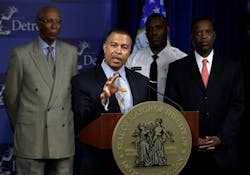Detroit Police Chief Nixes 12-Hour Shifts for Officers
As new FBI crime statistics show Detroit with its highest homicide rate in nearly 20 years, Police Chief James Craig is unveiling shorter shifts for police officers to boost morale among the rank and file -- the latest in a series of sweeping changes to the beleaguered department.
Detroit police had been working 12-hour shifts for more than a year as the department sought to reduce overtime costs. The long shifts were tough on officers, Detroit police spokesman Sgt. Michael Woody said.
"You're talking about a police officer for 12 hours a day in the city of Detroit going from run to run to run. The fatigue alone is a major issue," Woody said. "You're talking safety concerns, adequate services that can be provided."
Detroit emergency manager Kevyn Orr has made fighting crime a top priority as works to resurrect the city as it struggles through bankruptcy.
Under Orr's leadership, the Detroit Police Department is getting 50 new squad cars, replacement bulletproof vests and two new devices that Detroit police have never had: electric stun guns and on-body video cameras.
Craig, who took over the department in July, said he is restructuring to get more officers on the streets. Some special operations officers have been redeployed; the number of officers on the mayor's executive protection unit has been reduced, as has the number assigned to the City Council, and officers from Craig's office have been reassigned.
The new shift hours take effect Oct. 14. In addition to three eight-hour shifts a day, there will be an overlapping 10-hour shift for which officers can volunteer.
Woody said shorter shifts will provide a better mix on the street.
"Every few hours, you should expect a fresh officer out on the street," Woody said. "That can speak volumes."
The changes come as FBI statistics released this week show that the city of Detroit is second only to Flint in homicide and violent crime.
According to the FBI, Detroit witnessed 386 homicides in 2012. That put Detroit's 2012 homicide rate at 54.6 per 100,000, the highest such rate since 1993, when it was 57.6 per 100,000.
Detroit, however, saw fewer violent crimes, dropping from 15,245 in 2011 to 15,011 in 2012.
Flint had the highest homicide rate in the U.S. in 2012 as it saw 63 homicides, giving it a rate of 62.0 per 100,000 population. Flint also had the highest overall violent crime rate in the country, reporting 2,729 violent crimes per 100,000 population.
While Orr declined to comment on the latest FBI crime stats, he has argued several times that Detroit's crime problem cannot be tolerated.
"People should not have the view that Detroit is somehow irreplaceably crime-ridden," Orr said in an interview with the Free Press, later declaring: "Where we are is unacceptable."
According to the FBI, the nation as a whole is facing an uptick in violent crime. In 2012, the country witnessed 14,827 homicides, giving it a murder rate of 4.7 per 100,000 people. The nation's murder rate rose 0.4% from the year before, but dropped 12.8% from 2008.
Overall violent crime in the U.S. increased 0.7% in 2012, while property crimes decreased 0.9%, marking the 10th straight year of declines for those crimes, according to the FBI's statistics.
The FBI also released the following:
-- In 2012, there were an estimated 1,214,462 violent crimes in the U.S. Murder and non-negligent manslaughter, forcible rape and aggravated assault increased 1.1%, 0.2% and 1.1%, respectively. However, the estimated number of robbery offenses declined 0.1%.
-- Nationwide, there were an estimated 8,975,438 property crimes. The estimated number of burglaries declined 3.7% in 2012 when compared with the 2011 figure. The estimated number of larceny-thefts remained unchanged, and motor vehicle thefts increased 0.6%.
-- Collectively, victims of property crimes (excluding arson) suffered $15.5 billion in losses in 2012.
-- The FBI estimated that agencies nationwide made about 12.2 million arrests, excluding traffic violations, in 2012. The arrest rate for violent crime was 166.3 per 100,000 inhabitants, and the rate for property crime was 528.1 per 100,000 inhabitants.
-- By violent crime offense, the arrest rate for murder and non-negligent manslaughter was 3.5; forcible rape, 5.8; robbery, 33.1, and the aggravated assault, 123.9 per 100,000 inhabitants.
-- By property crime offense, the arrest rate for burglary was 90.7; larceny-theft, 411.9, and motor vehicle theft, 21.9. The arrest rate for arson was 3.7 per 100,000 inhabitants.
-- In 2012, there were 14,006 law enforcement agencies that reported their staffing levels to the FBI. These agencies reported that, as of Oct. 31, 2012, they collectively employed 670,439 sworn officers and 285,883 civilians, a rate of 3.4 employees per 1,000 inhabitants.
The FBI's statistics are based on responses from 18,290 law enforcement agencies from around the country, including city, county, state, university and college, tribal and federal agencies.
Copyright 2013 - Detroit Free Press
McClatchy-Tribune News Service
